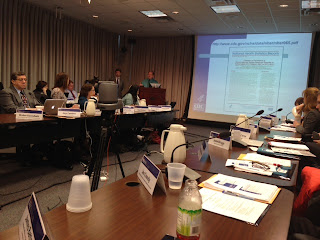Autism - is it really 1 in 50?
Photo: The Interagency Autism Coordinating Committee (IACC) in session at NIH in Bethesda, MD April 9, 2013. IACC meetings are streamed like and archived at iacc.hhs.gov
One of the first presentations at today’s IACC meeting explained the recent NCHS survey that found a 1
in 50 prevalence of autism in American school children. Stephen Blumberg from CDC and Michael Kogan
from HRSA presented their findings and answered questions.
There has been a lot of talk about this study in the media
these past few weeks. I was happy to have a chance to ask the project leaders
some questions about their work.
One of the most significant points the researchers made was
this: Their research methodology differed
quite a bit from the CDC methodology that led to last year’s 1 in 88
report. That makes it impossible to
compare the studies – and their results – directly. However, we can compare this study to itself,
since it was done before, in 2007. The
methodology between 2007 and last year did not change, yet the observed
prevalence rose dramatically (1 in 90 rose
to 1 in 50). Both researchers felt this
change from one survey cycle to another was significant.
But does it signal growing awareness, or something else?
The researchers found that roughly a third of the autistic
kids identified were diagnosed after the 2007.
Yet those kids were old enough to have been included in the original
2007 survey. Why weren’t they counted
last time? Presumably, they were
unrecognized.
In response to my question, the scientists agreed that the
National Survey of Children’s Health picked up “educational autism” whereas the
ADDM survey looked at medical records and only uncovered “medical autism.” It’s no surprise that identified prevalence
would vary when two different definitions are used.
Both studies returned valuable, valid findings. The actual
number of people with autism may lie somewhere between the two study
figures.
Some parents see issues with their children, and talk to
their pediatrician. That conversation
may lead to formal autism screening and diagnosis. Armed with that information, parents request
services from their schools and their health care provider.
Other times, parents don’t notice, or don’t take
action. School staff notices
abnormalities. Tests are done, and kids
are diagnosed with autism in the school.
The result: those kids are
provided with educational supports yet their diagnosis remains informal;
outside the medical system.
How many of those kids would also receive a “medical”
diagnosis of autism; one that would be validated by a gold-standard tool like
the ADOS? Unfortunately, we do not know. I’m not aware of a study that has made that
comparison.
There is a second issue with the NSCH study – that it is based
on telephone survey. Workers made
thousands of phone calls in their attempt to interview parents, but 75% of the
calls were unanswered. When an adult did
pick up the phone, the interview completion rate was approximately 54% for
landlines, and 42% on cell phones. The
comparable rate for 2007 was 66%
When so many people opt out of a study on disabilities in
kids, it stands to reason that many simply felt their kids had no issues so
there’s no reason to take part. That may
well result in a bias toward parents whose kids have issues, and a higher
identified prevalence.
So what can you take away from this latest news?
This study, and many others in recent years, highlights the huge
and growing number of kids who need special services in school. As the numbers of special needs diagnoses
have skyrocketed, school budgets have stagnated. How will we – as a society – address this
growing gap between identified need and voter-funded support to address it?
The differences in methodology between this study and the
earlier CDC work preclude direct comparison.
To me, this latest study confirms what many of us have suspected – there
is an explosion of autism awareness, especially among parents – since 2008. That’s a good thing, when it leads to more
successful kids. Are there circumstances
where it’s not so good?
This latest study provides autism advocates with another
piece of ammunition to argue for greater funding for services and support. At the same time, we must recognize that
opponents of funding increases will use studies like this, and the recent news
of ADHD prevalence (mentioned in the NY Times and other media) as
justification for another claim: that there is an epidemic of over-diagnosis
that should not be matched with increased funding. So the study will be used both for and
against our community.
The final point I’ll offer is that this recent study is once
again limited to a description of autism in kids. Just as we distinguish mildly affected kids
with educational autism diagnoses, we might distinguish geeky undiagnosed adults
from their more significantly affected adult peers. If this study is a guide, that geeky
population who might benefit from some support may be much bigger than
previously imagined.
I’ll be interested in your thoughts . . . .
John Elder Robison is an adult with autism. He’s the author of three books on autism and
difference – Raising Cubby (2013), Be Different (2011) and Look Me in the Eye
(2007)


.jpeg)



Comments
I disagree. I think it indicates that the question is invasive and parents want their privacy.
In the last ADDM study, 20% of autistic 8 yr olds had no previous diagnosis of an ASD.